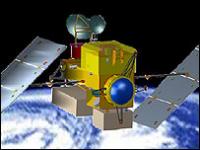







|
News and Information
Space network to track rainfall
| April 3, 2006 |

By Richard Black
Environment Correspondent, BBC News website, in Vienna
The network will provide detailed information on rainfall
The US and Japanese space agencies (Nasa and Jaxa) are to launch a satellite network to measure rainfall around the world.
The Global Precipitation Measurement (GPM) project will provide three-hourly reports on rainfall.
It aims to improve weather forecasting and understanding of how the global water cycle affects climatic change.
Details of the $1.1bn (£636m) project, due to begin in 2011, were presented at a conference in Vienna, Austria.
"The aim is to provide the best possible global precipitation measurement available from any sources," said Arthur Hou, GPM project scientist at Nasa's Goddard Space Flight Center near Washington DC.
"It is primarily a science mission, but folded into the science objectives is to improve algorithms for weather forecasting," he told the BBC News website.
"It will help with climate, because rainfall is a fundamental element in the climate, and also measuring soil moisture feedback would improve climate prediction."
Higher resolution measurement in the future may also help forecast floods and landslides.
'Satellites of opportunity'
The heart of the GPM will be a "core" satellite equipped to measure rainfall in two ways, via a dual-frequency radar and a passive microwave radiometer.
It will also serve as a calibration refererence for the rest of the satellite constellation.
These will come from a range of space agencies. Some will be designed explicitly for GPM, others "satellites of opportunity", launched for other projects but capable of putting data into the GPM system.
Between six and eight satellites will be involved altogether; using a range of instruments and in a variety of orbits, the idea is to provide a constantly-updated picture of rainfall around the world.
It extends a previous US-Japanese collaboration, the Tropical Rainfall Measuring Misssion.
"This takes it from the tropics to a global extent," said Dr Hou, "and also will enable us to measure lower rain rates as well as snow."
Dr Hou's presentation formed part of a sequence here at the European Geosciences Union (EGU) meeting on improving measurement of rainfall.
There was general agreement that better data was badly needed, particularly for rain over the oceans, where surface-based measurement was not easy.
Eyal Amitai, also from Goddard Space Flight Center with an additional post at George Mason University in Washington DC, is working on a new detection method involving sound.
"It is difficult to measure rainfall at sea," he said. "Rain gauges on board ships and on surface moorings are unstable and subject to vandalism; satellite observations are poor in temporal coverage and have large spatial averaging, whereas rain is highly variable in time and space."
During 2004, Dr Amitai's team conducted experiments with hydrophones - underwater sound detection devices - in the Ionian Sea.
By calibrating their observations against radar observations, they concluded that placing hydrophones one or two kilometres underwater could be an effective way to measure rainfall on the sea.
|
Source: www.bbc.com |
| http://news.bbc.co.uk/2/hi/science/nature/4872606.stm |
|
| Support Caprivi Freedom |
Fill out the form below to become a member of this site and receive our regular newsletter.
|

|

